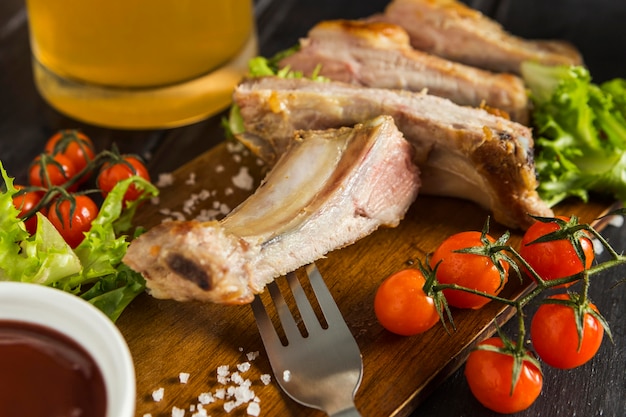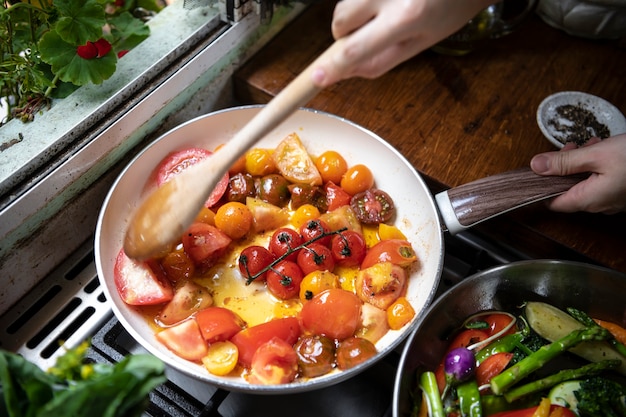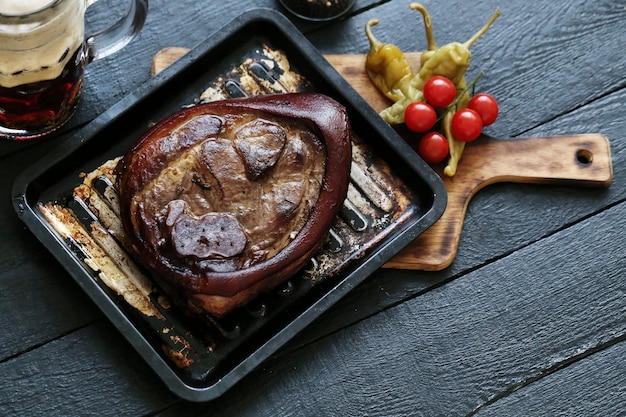(Part 1) The Basics: Understanding Pork Shoulder

1.1 What is Pork Shoulder?
Pork shoulder, also known as Boston butt, comes from the shoulder of the pig. It's a tough, flavorful cut, bursting with marbling and collagen, which is what makes it perfect for slow-cooking methods like braising and roasting. The high fat content makes it incredibly juicy and tender, turning a tough cut into a culinary delight. Think of it like a delicious, hearty puzzle waiting to be solved.
1.2 Why Does Temperature Matter?
Temperature is the key to unlocking the magic of pork shoulder. We're aiming for that sweet spot where the meat is cooked through, incredibly tender, and bursting with flavour. And, of course, we want to make sure it's safe to eat. Undercooked pork can be dangerous, so reaching the right internal temperature is essential. It's a balancing act between deliciousness and safety.
(Part 2) The Ideal Pork Shoulder Temperature

2.1 The Minimum Safe Temperature
The USDA recommends an internal temperature of 145°F (63°C) for pork shoulder. This ensures that any harmful bacteria are killed. However, at 145°F, the meat might be a bit dry and not quite as tender as we want it. It's safe, but not necessarily the most satisfying. So, let's aim for something a bit higher.
2.2 The "Pull-Apart" Temperature
The ideal temperature for a perfectly tender and juicy pork shoulder is around 195°F (91°C). This is when the collagen in the meat breaks down, creating that irresistible melt-in-your-mouth texture. This is when the meat starts to fall apart effortlessly, perfect for pulled pork sandwiches, tacos, or any other dish that calls for that tender, shredded goodness.
2.3 The "Doneness" Factor
Remember, 195°F is just a guideline. It depends on the size of the shoulder and the cooking method you choose. For example, if you're using a smoker, you might want to go a bit higher, aiming for around 203°F (95°C). For a braised shoulder, 195°F is a good target. It's all about finding that sweet spot where the meat is cooked through but still incredibly juicy and tender. It's a bit of an art, but with practice, you'll get the hang of it.
(Part 3) Measuring the Temperature

3.1 The Importance of Accuracy
You can't just rely on looking at the pork to determine doneness. You need a reliable meat thermometer to get an accurate reading. Invest in a good quality digital thermometer with a long probe, one that can reach the center of the thickest part of the shoulder. Don't settle for a cheap thermometer; you need one that can give you accurate readings to ensure your pork is cooked to perfection.
3.2 Where to Insert the Thermometer
Always insert the thermometer into the thickest part of the shoulder, avoiding any bone. You want to be sure you're getting a reading from the center of the meat, not just the surface. Imagine the pork shoulder is a globe, and you want to find the exact center of that globe.
(Part 4) Cooking Methods and Temperature Adjustments
4.1 slow roasting
Slow roasting is a classic way to cook pork shoulder, and it's a method I often use. The low and slow heat helps the meat become incredibly tender and flavorful. It's like giving the pork shoulder a warm hug in the oven. Start with a temperature around 300°F (150°C), and aim for an internal temperature of 195°F (91°C) or slightly higher.
4.2 Braising
Braising combines dry heat and moist heat, resulting in incredibly flavorful and tender meat. It's like giving the pork shoulder a spa treatment, a combination of heat and moisture to achieve ultimate tenderness. Start by browning the shoulder, then transfer it to a dutch oven with liquid, such as broth or wine. Bring it to a simmer and let it cook until the meat is tender, around 195°F (91°C).
4.3 Smoking
Smoking is a fantastic way to add incredible smoky flavour to your pork shoulder. It's a method that takes time and patience, but the results are worth it. For smoking, I aim for a temperature of around 225°F (107°C), and let it smoke for a long time, until the internal temperature reaches 203°F (95°C). The result is a smoky, succulent, and fall-apart tender shoulder. It's a flavour explosion, perfect for those who appreciate a smoky touch.
4.4 instant pot
For a faster option, consider using an Instant Pot. It's a great way to get tender and flavorful pork shoulder in a fraction of the time. Follow the manufacturer’s instructions, and remember to adjust the cooking time based on the size of your shoulder. Aim for an internal temperature of 195°F (91°C). It's a fantastic option for those busy weeknights when you need a delicious meal on the table quickly.
(Part 5) Resting the Meat
5.1 Why Resting is Important
After cooking, it's crucial to let the pork shoulder rest for at least 30 minutes. This allows the juices to redistribute throughout the meat, resulting in a more tender and juicy end product. It's like giving the meat a chance to catch its breath and relax after its culinary adventure. Cover the shoulder with foil while it rests. This will help to keep it warm and moist.
5.2 The Resting Process
I usually transfer the pork shoulder to a cutting board, cover it with foil, and let it rest for at least 30 minutes. While it's resting, I like to make the sauce or prepare the sides. It's the perfect time to get those finishing touches ready, so your meal is perfectly coordinated.
(Part 6) Checking for Doneness
6.1 The Thermometer Test
The thermometer is your best friend when it comes to determining doneness. Insert the thermometer into the thickest part of the shoulder and make sure it reaches 195°F (91°C) or higher. But don't stop there!
6.2 The "Pull-Apart" Test
After the thermometer reads the desired temperature, gently pull the shoulder apart with two forks. If the meat falls apart easily, you're good to go. If it still feels tough, give it a little more time in the oven or smoker. It's a simple test, but a reliable one.
6.3 Visual Clues
While not as reliable as a thermometer, you can also look for visual clues. The meat should be a deep golden brown color and should have a slightly crusty surface. But remember, don't rely solely on visual cues. Always use a thermometer for an accurate reading. Your eyes might be fooled, but a thermometer won't lie.
(Part 7) Serving and Enjoying Your Pork Shoulder
7.1 Shredding the Meat
Once the pork shoulder has rested, it's time to shred it. Use two forks to pull the meat apart, creating those delicious, juicy strands that are perfect for pulled pork sandwiches, tacos, or any other dish you can imagine.
7.2 Serving Suggestions
There's no shortage of ways to serve your perfectly cooked pork shoulder. Here are a few ideas to get your creative juices flowing:
- Pulled pork sandwiches: Serve on buns with your favorite toppings, like coleslaw, pickles, and bbq sauce. It's a classic for a reason.
- Tacos: Fill soft or hard tortillas with shredded pork, salsa, avocado, and other toppings. It's a quick and satisfying meal that can be customized to your taste.
- Nachos: Pile on a platter with chips, cheese, salsa, and sour cream. It's a perfect party appetizer or a hearty meal for a casual night in.
- Pork shoulder hash: Combine shredded pork with potatoes, onions, and peppers for a hearty and satisfying meal. It's a great way to use up leftovers and create a delicious dish.
- Pork shoulder salad: Add shredded pork to your favorite greens with a vinaigrette dressing. It's a light and refreshing way to enjoy your pork shoulder.
(Part 8) Tips for the Perfect Pork Shoulder
8.1 Don’t Be Afraid to Season
Season your pork shoulder generously with salt, pepper, and other herbs and spices. It's a blank canvas, ready to absorb all the delicious flavors you throw at it. Be bold with your seasonings, and don't be afraid to experiment with different combinations.
8.2 Use a Rub
Try using a dry rub on your pork shoulder. A good rub can add incredible flavor and depth. Experiment with different combinations of spices and herbs. It's a fantastic way to create a flavorful crust on the outside of the meat.
8.3 Inject Flavor
Consider injecting your pork shoulder with a flavorful marinade, like apple cider or BBQ sauce. It will help to infuse the meat with moisture and flavor. It's a great way to add an extra layer of deliciousness to your pork shoulder.
8.4 Slow and Low is the Key
The key to tender, juicy pork shoulder is low and slow cooking. Don't rush the process! Let the meat cook slowly and evenly. Patience is a virtue in cooking, especially when it comes to pork shoulder. The slow cooking process allows the collagen to break down, creating that incredibly tender texture we all crave.
8.5 Don’t Overcook It
While we want the meat to be tender and juicy, be careful not to overcook it. overcooked pork can be dry and tough. Use a thermometer to ensure it reaches the desired temperature, but don't cook it any longer than necessary. It's a delicate balance, but one worth striving for.
8.6 Don’t Be Afraid to Experiment
Don't be afraid to experiment with different flavors and techniques. The world of pork shoulder is your oyster! Try different spices, marinades, and cooking methods to find what you like best. It's all about finding your perfect pork shoulder recipe. The possibilities are endless!
(Part 9) FAQs
Q: How long does it take to cook a pork shoulder?
The cooking time for a pork shoulder depends on the size of the shoulder and the cooking method. A 5-pound shoulder can take anywhere from 6 to 8 hours in a slow cooker, while a 10-pound shoulder might take 10 to 12 hours. Smoking can take even longer, anywhere from 12 to 16 hours. It's a long process, but the results are worth the wait.
Q: Can I cook pork shoulder in a pressure cooker?
Yes, you can cook pork shoulder in a pressure cooker, but it's not the best method for getting that melt-in-your-mouth texture. You'll likely need to cook it for a shorter period of time, which may result in a slightly tougher texture. However, it's a great option if you're short on time. It's a good way to get a decent meal on the table quickly.
Q: What should I do with leftover pork shoulder?
There's no such thing as leftover pork shoulder! It's so good, you'll likely eat it all. But, if you do have leftovers, you can reheat them in the oven or microwave. You can also use them in tacos, burritos, salads, or soups. It's a versatile ingredient, so get creative with your leftovers.
Q: Is it safe to eat pork shoulder that's been sitting out at room temperature?
No, it's not safe to eat pork shoulder that's been sitting out at room temperature for more than two hours. Bacteria can grow rapidly in food left at room temperature, which can make you sick. Always refrigerate or freeze pork shoulder within two hours of cooking. food safety is crucial, so always be mindful of how long you're leaving cooked pork at room temperature.
Q: How can I tell if my pork shoulder is bad?
If you're unsure about the safety of your pork shoulder, it's best to err on the side of caution and throw it away. Signs that your pork shoulder might be bad include a sour or off smell, a slimy texture, or a change in color. Trust your senses, and if something doesn't seem right, it's best to toss it out.
Conclusion
There you have it, the ultimate guide to cooking the perfect pork shoulder. Remember, it's all about reaching the right temperature, resting the meat properly, and, most importantly, enjoying the delicious results. Grab your thermometer, your favorite spices, and get ready to create a truly satisfying meal that will leave everyone asking for more. So, what are you waiting for? Get in the kitchen and start cooking!
Everyone is watching

Prime Rib Roast Cooking Time Chart: Per Pound Guide
Cooking TipsPrime rib roast. Just the name conjures images of lavish dinners, crackling fires, and hearty laughter. It’s ...

How Long to Bake Potatoes in the Oven (Perfect Every Time)
Cooking TipsBaked potatoes are a staple in my kitchen. They're incredibly versatile, delicious, and surprisingly easy to m...

Perfect Rice Every Time: The Ultimate Guide to Cooking Rice
Cooking TipsAs a self-proclaimed foodie, I've always been a bit obsessed with rice. It's the foundation of countless cuisi...

The Ultimate Guide to Cooking Asparagus: Tips, Techniques, and Recipes
Cooking TipsAsparagus. The mere mention of this spring delicacy conjures up images of vibrant green spears, crisp and burs...

Ultimate Guide to Cooking the Perfect Thanksgiving Turkey
Cooking TipsThanksgiving. Just the word conjures up images of overflowing tables laden with delicious food, the scent of r...
